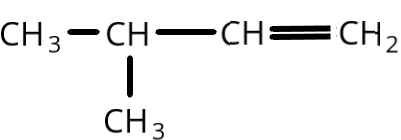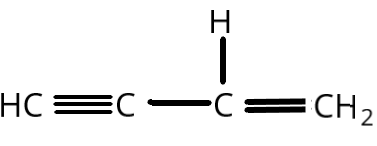
Which of the following organic compound will give a mixture of \[1 - \]chloro butane and \[2 - \]chlorobutane on chlorination
A. 
B. 
C. \[C{H_2} = CH - CH = C{H_2}\]
D. \[C{H_2} = CH - C{H_2} - C{H_3}\]
Answer
224.4k+ views
Hint: Alkenes undergo chlorination reactions in which the chlorine atom added to the carbon atom which was earlier forms a double bond. Alkenes can be chlorinated using hydrogen chloride according to the Markovnikov addition rule to give a major product.
Complete Step-by-Step Explanation:
In order to know that alkanes get chlorinated when chlorine is added to them. Another name for it is hydrogen halogenation. Halogenation typically takes place in hot or sunny environments. An illustration of an addition reaction is hydrogen halogenation reaction. An electrophilic addition has occurred. In this location, hydrogen chloride oxidized to protons and chloride ions. A carbocation is created when the proton is bound to the alkene breaking the double bond. Rearrangements can then take place to create a more stable carbocation. The product is then attacked by chlorine.
An alkene with four carbons and a double bond at the first carbon can be chlorinated to produce the required products. Here, only the products \[1 - \]chlorobutane and \[2 - \]chlorobutane can occur if the double bond is present in the first carbon.
Therefore, the correct option is: (D) \[C{H_2} = CH - C{H_2} - C{H_3}\].
Option ‘D ’ is correct
Note: It should be noted that the electron donation makes the double bond(=) more reactive and abundant in the alkyl groups' electrons. In contrast, the double bond becomes less reactive and electron-deficient when electron-withdrawing groups, such as floro, nitro, are present.
Complete Step-by-Step Explanation:
In order to know that alkanes get chlorinated when chlorine is added to them. Another name for it is hydrogen halogenation. Halogenation typically takes place in hot or sunny environments. An illustration of an addition reaction is hydrogen halogenation reaction. An electrophilic addition has occurred. In this location, hydrogen chloride oxidized to protons and chloride ions. A carbocation is created when the proton is bound to the alkene breaking the double bond. Rearrangements can then take place to create a more stable carbocation. The product is then attacked by chlorine.
An alkene with four carbons and a double bond at the first carbon can be chlorinated to produce the required products. Here, only the products \[1 - \]chlorobutane and \[2 - \]chlorobutane can occur if the double bond is present in the first carbon.
Therefore, the correct option is: (D) \[C{H_2} = CH - C{H_2} - C{H_3}\].
Option ‘D ’ is correct
Note: It should be noted that the electron donation makes the double bond(=) more reactive and abundant in the alkyl groups' electrons. In contrast, the double bond becomes less reactive and electron-deficient when electron-withdrawing groups, such as floro, nitro, are present.
Recently Updated Pages
JEE Main 2026 Session 1 Correction Window Started: Check Dates, Edit Link & Fees

JEE Isolation, Preparation and Properties of Non-metals Important Concepts and Tips for Exam Preparation

Isoelectronic Definition in Chemistry: Meaning, Examples & Trends

Ionisation Energy and Ionisation Potential Explained

Iodoform Reactions - Important Concepts and Tips for JEE

Introduction to Dimensions: Understanding the Basics

Trending doubts
JEE Main 2026: City Intimation Slip and Exam Dates Released, Application Form Closed, Syllabus & Eligibility

JEE Main 2026 Application Login: Direct Link, Registration, Form Fill, and Steps

Understanding the Angle of Deviation in a Prism

How to Convert a Galvanometer into an Ammeter or Voltmeter

Hybridisation in Chemistry – Concept, Types & Applications

Ideal and Non-Ideal Solutions Explained for Class 12 Chemistry

Other Pages
NCERT Solutions For Class 12 Chemistry Chapter 1 Solutions - 2025-26

JEE Advanced Marks vs Ranks 2025: Understanding Category-wise Qualifying Marks and Previous Year Cut-offs

Solutions Class 12 Chemistry Chapter 1 CBSE Notes - 2025-26

NCERT Solutions ForClass 12 Chemistry Chapter Chapter 4 The D and F Block Elements

Biomolecules Class 12 Chemistry Chapter 10 CBSE Notes - 2025-26

NCERT Solutions For Class 12 Chemistry Chapter 10 Biomolecules - 2025-26




